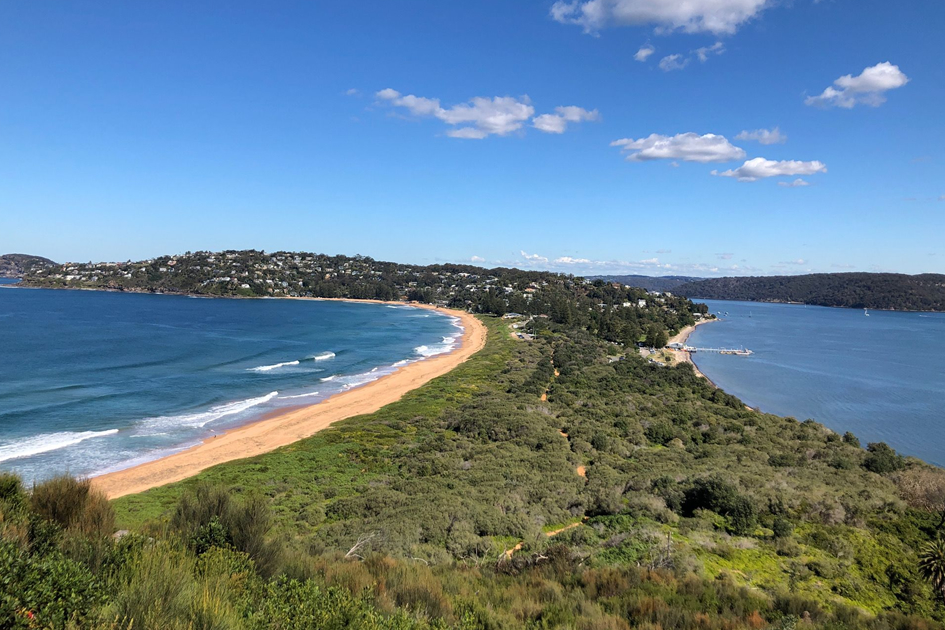Ku-ring-gai Chase National Park
The park takes over 100km of coastline along the southern edge of Broken Bay, where it heads into the Hawkesbury River. Two unconnected principal sections are Bobbin Head and the West Head area. The Barrenjoey headland at Palm Beach is also part of the park and the site of a historic lighthouse.
The second national park in Australia, Ku-ring-gai, was created in 1894. Its name comes from its original inhabitants, the Guringai people, who were all but wiped out just after colonization through violence at the hands of settlers and the devastating introduction of smallpox. It’s well worth reading Kate Grenville’s The Secret River for an engaging but harrowing telling of this story.
Remnants of pre-colonial Aboriginal life are visible today thanks to the preservation of more than 800 sites, including rock paintings, middens, and cave art.
Walks
Elevated park sections offer glorious water views over Cowan Creek, Broken Bay, and Pittwater. If you want information about walking trails, please stop at the Bobbin Head Information Centre, operated by the NSW National Parks & Wildlife Service. There is a marina, picnic areas, a cafe, and a boardwalk leading through mangroves at Bobbin Head.
Waterfalls
Upper Gledhill Falls is a relatively easily accessible waterfall inside the park and a popular ‘secret’ wild swimming spot for competent swimmers.
Further downstream along McCarrs Creek, a series of cascades, including another swimming spot, Duck Hole or Duck Pond, with a large sandy bank on one side.
Camping
The Basin Campground is a remote camping spot accessed by ferry with basic facilities: a shower block, toilets, picnic tables, and drinking water. Campers need to be well-prepared and self-sufficient. Sites are pre-booked via the NSW National Parks & Wildlife Service website.
Picnic areas
The park has multiple picnic areas, toilets, and drinking water taps; some also have BBQ areas.
Entry fee
As with all Australian national parks, there are entry fees for vehicles per person daily. More information on current prices and how to pay can be found on the NSW National Parks & Wildlife Service website.
How to get to Ku-ring-gai Chase National Park
Access to the park is by the Palm Beach water taxi or by car via McCarrs Creek Rd (off Mona Vale Rd, Terrey Hills) for West Head or via Bobbin Head Rd (North Turramurra) or Ku-ring-gai Chase Rd (Mount Colah) for Bobbin Head.
Accommodation
As well as camping and a YHA at Pittwater and Collaroy, accommodation options include houseboats on the Hawkesbury River and a Sydney Lakeside Holiday Park in nearby Narrabeen.
Ku-ring-gai Chase National Park: A Brief History
Ku-ring-gai Chase National Park is a national park located in Sydney, Australia. It is Australia’s third oldest national park, known for its beautiful scenery, diverse wildlife, and rich Aboriginal heritage.
The Guringai people, an Aboriginal Australian tribe, first inhabited the area around Ku-ring-gai Chase National Park. The Guringai lived in the area for thousands of years, and their descendants still live in the region today.
The first European to visit the area was Captain Arthur Phillip, the commander of the First Fleet. Phillip landed at Manly Cove on January 26, 1788, and explored the surrounding area. He named the area “Ku-ring-gai Chase,” which means “place of the stingray” in the Guringai language.
In the colony’s early years, Ku-ring-gai Chase was used as a source of food and timber. The Guringai people were displaced from their land, and many died from diseases the Europeans brought.
In the late 19th century, Ku-ring-gai Chase became a popular spot for recreation. Several bushwalking trails were established, and the area became a popular destination for swimming, fishing, and boating.
In 1894, Ku-ring-gai Chase was declared a national park. This was the third national park to be established in Australia, after Royal National Park and Dandenong Ranges National Park.
Today, Ku-ring-gai Chase National Park is a popular tourist destination. It is home to various plant and animal life, including kangaroos, koalas, and platypus. The park has several historical sites, including Aboriginal middens and European homesteads.
Some of the notable events in the history of Ku-ring-gai Chase National Park include:
- 1788: Captain Arthur Phillip lands at Manly Cove.
Captain Arthur Phillip landing at Manly Cove, Australia
- 1794: The first European settlers arrived in the area.
- 1894: Ku-ring-gai Chase is declared a national park.
- 1916: The Bobbin Head ferry service is established.
- 1958: The Ku-ring-gai Chase National Park Act is passed.
- 1967: The park is added to the Australian National Heritage List.
- 1988: The park celebrates its 100th anniversary.
Ku-ring-gai Chase National Park is a beautiful and essential part of Sydney’s history. It is a place where people can enjoy the area’s natural beauty, learn about its Aboriginal heritage, and explore its historical sites.

